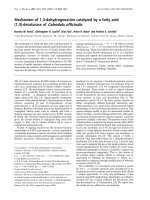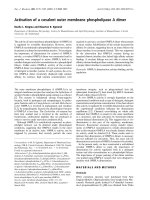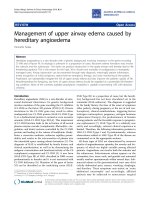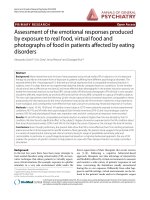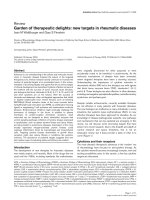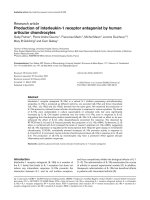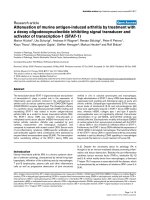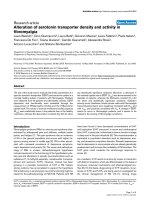Báo cáo y học: "anagement of upper airway edema caused by hereditary angioedema" pptx
Bạn đang xem bản rút gọn của tài liệu. Xem và tải ngay bản đầy đủ của tài liệu tại đây (292.26 KB, 8 trang )
REVIE W Open Access
Management of upper airway edema caused by
hereditary angioedema
Henriette Farkas
Abstract
Hereditary angioedema is a rare disorder with a genetic backgr ound involving mutations in the genes encoding
C1-INH and of factor XII. Its etiology is unknown in a proportion of cases. Recurrent edema formation may involve
the subcutis and the submucosa - the latter can produce obstruction in the upper airways and thereby lead to life-
threatening asphyxia. This is the reason for the high, 30-to 50-per-cent mortality of undiagnosed or improperly
managed cases. Airway obstruction can be prevented through early diagnosis, meaningful patient information,
timely recognition of initial symptoms, state-of-the-art emergency therapy, and close monitoring of the patient.
Prophylaxis can substantially mitigate the risk of upper airway edema and also improve the patients’ quality of life.
Notwithstanding the foregoing, any form of upper airway edema should be regarded as a potentially life-threaten-
ing condition. None of the currently available prophylactic modalities is capable of preventing UAE with absolute
certainty.
Introduction
Hereditary angioedema (HAE) is a rare disorder of auto-
somal dominant inheritance. Its genetic background
involves mutation of the gene encoding the C1-inhibitor
(C1-INH) or the factor XII protein (FXII) [1,2]. Diverse
mutations in the C1-INH gene may result in e ither
inadequately low C1-INH protein (HAE-C1-INH-Type
I) or a dysfunctional protein in normal or even excessive
amounts ( HAE-C1-INH-Type II)[3,4]. This impairment
of C1-INH function leads to the activation of all several
plasma enzyme cascade (comple ment, fibrinolytic , coa-
gulation, and kinin) systems controlled by the C1-INH
protein and leading to the release of bradykinin. Brady-
kinin, a vasoactive mediator, enhances capillary perme-
ability and results in the extravasation of plasma into
the interstitial space causing edema formation [5]. The
diagnosis of HAE is established by family history and
clinical manifestation, as well as by determining the
antigenic concentration and functional activity of the C4
complement component and C1-INH [3]. A new form
(HAE-FXII-Type III) of HAE, described i n 2000, occurs
predominantly i n females and it is not associated with
C1-INH deficiency [6]. Mutation of the gene of factor
XII can be identified as the underlying cause (HAE-
FXII-Type III) in a proportion of cases, but the heredi-
tary background has not been elucidated yet in the
remainder (HAE-unknown). Thediagnosisissuggested
by the family history, the time of the onset of symptoms
(after puberty, during pregnancy or the use of oral con-
traceptives), clinical manifestations, triggering factors
(estrogen contraceptives, pregnancy, estrogen hormone
replacement therapy), the predominance of females
among patients, and the favorable response to progester-
one replacement [7]. HAE-Type III is a relatively new
entity and accordingly, relevant clinical experience is
limited. Therefore, the following information pertains to
HAE-C1-INH-Types I and II predominantly, whereas
observations related to HAE-Type III of the disease are
commented on in the appropriate sections.
All three types of HAE are characterized by recurrent
attacks of angioedematous episodes, the severity and fre-
quency of which are highly variable among affected
patients. A ngioedema can invo lve both the subcutis and
the submucosa. Subcutaneous edema appears on the
extremities, face, torso, neck, and genitals and untreated
usually resolves spontaneously within several days. Sub-
mucosal edema in the gastrointestinal tract ma y elicit
colicky abdominal pain, nausea, vomiting, dysphagia,
and diarrhea. These symptoms may mimic an ‘ acute
abdominal catastrophe’ and accordingly, afflicted
patients may be subjected to unnecessary surgical
Correspondence:
3
rd
Department of Internal Medicine, Faculty of Medicine, Semmelweis
University, H-1125 Budapest, Kútvölgyi út 4, Hungary
Farkas Allergy, Asthma & Clinical Immunology 2010, 6:19
/>ALLERGY, ASTHMA & CLINICAL
IMMUNOLOGY
© 2010 Farkas; licensee BioMed Central Ltd. This is an Open Access article distributed under the terms of the Creative Commons
Attribution License ( which permits unrestricted use, distribution, and reprodu ction in
any medium, provided the original work is properly cited.
exploration during attacks [3]. Edema of the airway
mucosa may cause life-threatening asphyxia from
obstruction. It involves primarily the mucosa of the
upper airways and only rarely manifests as pulmonary
edema. The exact pathomechanism of this phenomenon
is as yet unknown [8-10].
Edema of airway the upper (UAE) in HAE
1. UAE Mortality
Upper airway edema (UAE) may lead to asphyxia by
causing airway obstruction with 30-to 50-per-cent mor-
tality of undiagnosed or inappropriately managed ca ses
[3,11-13]. Bork recorded 29 deaths from suffocation in
his series of patients [14]. Before diagnosis, asphyxia
tentatively attributed to HAE-C1-INH occurred in six of
the 49 families follow ed up at the Hungarian HAE Cen-
ter. One family lost three of its members to upper air-
way obstruction. Although the mortality of UAE has
improved dramatically, fatal cases still occur. According
to our Hungarian records of the last 15 years, one
patient has died of asphyxia due t o airway obstruction.
Fatal outcome was related to delays in initiating emer-
gency therapy, lack of material and personal precondi-
tions for establishing airway patency, and poor
compliance of the patient.
2. UAE Nomenclature
In p ublications, UAE is referred to simply as ‘laryngeal
edema’. This term, however, does not describe the con-
dition accurately, as edema often involves the mucosa of
the meso-and hypopharynx in addition. Intriguingly,
edema-formation spares the mucosa of the nasal cavity
and of the paranasal sin uses. The exact anatomical loca-
tion of the edematous swelling remains uncharted in a
large proportion of cases, because patients are only
rarely seen by ENT specialists during the attacks. We
know of no objective endoscopic evidence on the per-
centage of true cases of laryngeal edema amon g the
instances labeled as ‘laryngeal edema’ or on the distribu-
tion of these cases according to involvement of the indi-
vidual anatomical segments of the larynx. In the
majority of publications, laryngeal involvement is
inferred from indirect signs only (deepening of the
patient’svoice,hoarseness,aphonia,etc.).Therefore,
replacing the term ‘laryngeal edema’ with ‘upper airway
edema (UAE)’ seems more appropriate and accurate.
3. The diagnosis of UAE
3.1. Clinical manifestations and localization of UAE
Recognizing airway involvement is of primary impor-
tance especially for the patients since outcome of an
attack is often determined by the promptness of obtain-
ing medical help and receiving early appropriate therapy.
Thefollowingarepotential,subjectivesymptomsof
UAE (ranked in increasing severity):
• Sore, scratchy, itchy throat
•‘Something has stuck in the throat’
• Lump sensation in the throat
• Feeling of throat tightness
• Dysphagia
• Voice changes
• High-pitched or hoarse voice
• Roughness of voice
• Resonant, ‘barky’ cough
• Stridor
• Dyspnea
• Fear of suffocation
• Aphonia
• Inability to breathe, speak or cough - the patient
may grasp his/her t hroat with thumb and index fin-
gers (i.e. exhibiting the universal choking sign)
• Anxiety and agitation
Edema of the face and lips usually comprises approxi-
mately 3% (1.8% in our series) of the episodes of subcu-
taneous edema [15]. It should be regarded as an
important “initial” symptom, because UAE is preceded
by facial/labial edema in 15 to 30 per cent of cases.
Edematous swelling of the face is more common in
HAE-FXII [7]. Edema of the tongue occurs as an iso-
lated phenomenon in about 12% of episodes; however, it
may also accompany pharyngeal edema or UAE [16].
The incidence of lingual edema was substantially lower
being only 0.02% in our patient population. Remarkably,
involvement of the tongue is much more frequent in
(similarly bradykinin-mediated) angioedema induced by
ACEIs, ARBs and HAE-FXII [17]. UAE may also accom-
pany edema of the extr emities, but it only seldom
occurs during an abdominal edematous attack [16].
3.2.TheclinicalcourseofanUAEattackIn general,
UAE evolves into a severe condition over several hours
(median: 8.3 hours). Occasionally, the aggravation of
pre-existing, mild symptoms takes only minutes owing
to the rapid propagation of edema. Alternatively, the
episode may follow an inherently fulminant course or its
symptoms may resolve spontaneously [15]. The conse-
quences of obs truction become apparent sooner in chil-
dren because of smaller airway diameter, reduced
physiological reserve, and easy fatigability of respiratory
muscles. While in adults, edematous swelling of 1 mm
thickness causes a 27-per-cent reduction of airway
cross-sectional area, it represents reduction of 44% in
children and 75% in neonates. Thus, only minor swel-
ling of the airway mucosa can cause severe breathing
difficulty in children. Tonsils or adenoid hypertrophy
may further aggravate dysphagia and dyspnea [18,19].
3.3. The onset and frequency of UAE symptoms
Although angioedema episodes may occur at any age,
Farkas Allergy, Asthma & Clinical Immunology 2010, 6:19
/>Page 2 of 8
their initial onset in HAE-Type I and II is usually
observed between 6 and 8 years of age, as well as during
adolescence [3]. In HAE-Type III-FXII most symptoms
start in the second decade of life [7]. In g eneral, UAE
first occurs after the age of 11 and up to 21 years. How-
ever, it has been observed as early age as 3 years and as
advanced age as 78 years [15]. Our observations confirm
this wide age range of occurrence. UAE is uncommon
as an initial symptom In our series, UAE was the initial
manifestation of the disease in 7 out of 132 patients (all
are young females). This corresponds to 5.3% of total
attack number, which is similar to the 6.3-per-cent pro-
portion seen after diagnosis (n = 489/7044). BORK has
described laryngeal e dema as the initial symptom in a
single, 9-year-old pediatric case only, and the proportion
of UAE compared to total attack number was 0.8% (n =
1/125) [15]. The proportions of pa tients who have ever
experienced an UAE are stated by various authors as
follows: AGOSTONI-48% [9]; PRUET-50% [20];
CICARDI-78% [12]; BYGUM-55% [21]; BORK-49.6%
[15]. We found 56% in our series. UAE occurs more fre-
quently between 21 and 40 years of age, than during
either childhood or during adulthood.
3.4. Physical exam ination Signs and symptoms of UAE
may include:
• Voice changes
• Hoarseness
• Roughness of voice
• Resonant, ‘barky’ cough
• Stridor
• Dyspnea
• Aphonia
• Anxiety and agitation
• Desperate attempts to breathe, accompanied by
intercostal and supraclavicular retractions
• Rapidly progressive cyanosis
• Diminishing respiratory effort
• Loss of consciousness
• Elevated blood pressure and tachycardia, f ollowed
by hypotension and bradycardia
• Cardiac arrest
• Death is inevitable if the asphyxiating obstruction
is not relieved within 2-5 minutes after its onset
Edema of the soft palate, pharyngeal arch, uvula, and
the tongue is easy to ascertain using a spatula, whereas
evaluating the condition of the larynx requires endo-
scopic inspection by a specialist. The latter, however, is
uncommon or unfeasible in everyday practice, because
the emergency management of UAE is only seldom
undertaken by an ENT department. Indirect laryngo-
scopy, a more straightforward method for the evaluation
of the larynx, is difficult to perform in pediatric patients
owing to the lack of co-operation. Examination may fail
also in adults if the pharyngeal reflex is hyperactive.
Furthermore, mechanical contact betw een the pharyn-
geal wall and the laryngoscope may result in the pro-
gression of edema. Performing indirect laryngoscopy is
also difficult in the presenc e of marked lingual edema.
Flexible naso-pharyngo-laryngoscopy may prove appro-
priate for inspection for airway edema. The visual
appearance of the edematous swelling does n ot differ
from that caused by edema of other etiologies (such as
inflammatory, allergic)
3.5. Triggering factors It has been reported that
approximately 58% of patients can identify one or
more provoking factors of their edematous attacks [9]
but this proportion was 85% in our series. Known trig-
gering factors of HAE attacks include mechanical
trauma, emotional stress, surgical or diagnostic proce-
dures performed in the head and neck region, physio-
logical fluctuations of sexual hormones (during
puberty, menstruation, pregnancy), certain f oodstuffs
and medicinal products (such as estrogen-containing
oral contraceptives and OCs, ACE inhibitors). In UAE,
the range of identifiable triggering factors is different
[15], the most common being surgical or diagnostic
procedures in the head and neck region (such as endo-
tracheal intubation). Dental surgery is a leading cause,
potentially associated with fatal UAE [15,22-24]. Before
the diagnosis of HAE is established, facial edema or
UAE associated with a dental procedure may be mista-
ken for an allergic reaction to the local anesthetic and
this may delay recognizing the true nature of the
emergency. Although only rarely emphasized as a
potential provoking factor, acute upper a irway infec-
tion was identified as the triggeri ng factor of UAE in
38% of our 139 patients. Consecutive edema of the
face or lips, occurring through indirect mechanisms
after mechanical trauma to the head, face or neck
often progresses to involve the mucosa of the upper
airways. In HAE-Type III-FXII, the introduction of
oral contraception and the first pregnancy both can
induce the onset of initial symptoms [7].
3.6. Differential diagnosis The following disorders may
be considered if symptoms suggestive of upper airway
obstruction ensue in a patient with known HAE: infec-
tions (laryngitis, tonsillitis, peritonsillary absecess, epi-
glottitis), allergic conditions, neoplasm, foreign body,
poisoning, autoimmune disease, endocrine disease, gas-
tro-esophageal reflux, and functional abnormalities
(CNS depression, neuromuscular dysfunction, peripheral
nervous system abnormalities) [11]. These conditions
may be distinguished from each other through evalua-
tion of the patient’s history, the fin dings of the physical
examination , observ ed cl inical manifestations, a nd
laboratory abnormalities.
Farkas Allergy, Asthma & Clinical Immunology 2010, 6:19
/>Page 3 of 8
Useful clues to clarify theetiologyofUAEepisodes
occurring before HAE is diagnosed include a positive
family history, recurrent subcutaneous edema or several-
days-long episo des of colicky abdominal pain, accompa-
nied by nausea and vomiting. Another sign of potential
differential diagno stic significance is that the drugs con-
ventionally used to relieve airway edema (such as gluco-
corticoids, antihis tamines, and epinephrine) - known to
achieve particularly rapid improvement in children in
comparison to adults - tend to be ineffective in reducing
edematous swelling caused by HAE [25].
4. Management
4.1 Patient education Informing the patients about
UAE is an important component of their education. I t
must be stressed that virtually any type of airway edema
can lead to a potentially life-threatening condition. The
manifestations of UAE should be explained in detail,
because early recognition of relevant signs and symp-
toms may affect the outcome of the episode. Care
should be taken though not to scare the patient while
emphasizing the dangers of UAE. Patients should know
that while it is not possible to predict the time of onset
and localization of the attack, the risk of developing
UAE is increased by edema of the face, lips and tongue
of the neck. Additional risk factors include procedures
performed in the head and neck region, intratracheal
narcosis (in patients with a history of UAE), and age
between 11 and 45 years of age [15]. Patients should
receive verbal and written information on their disease
and its p otential manifestation s. They should be given a
medical information card for emergencies and a patie nt
diary for recording the occurre nce of symptoms and the
use of treatments. Medication to relieve acute edema-
tous attacks should also be provided (such as C1-INH) -
regardless of whether or not the patient has already
experienced a severe episode previously.
4.2 Management of UAE event Whenever it is sus-
pected, the therapy of UAE should be started as early
after recognition of ons et of initi al symptoms as possi-
ble. Edema of the face, lips, and neck require immediate
intervention. Current options for pharmacotherapy in
this treatment setting include plasma-derived C1-INH
replacement therapy (pdC1-INH), icatibant (a bradyki-
nin receptor antagonist), and ecallantide (a kallikrein
inhibitor). More than 30 years of clinical experience
exists using pdC1-INH. Intravenous administration of
this agent in a 500 to 1000 U dose is followed by sub-
stantial improvement of clinical symptoms within 30 to
60 minutes. In the vast majority of cases, treatment with
pdC1-INH usually eliminates symptoms completely
within 12 hours [9,12,15,26-29]. Double blind, placebo-
controlled studies conducted recently with pdC1-INH
concentrate established its recommended dose at 20 U/
kg. PdC1-INH concentrate is safe and effective with
minimal side e ffects The viral safety of preparations
manufactured using innovative pasteurization and nano-
filtration technologies is excellent [30]. Treatment with
pdC1-INH c oncentrate does not lead to the formation
of antibodies [31] and is safe for children, pregnant
women, and nursing mothers [28]. Only limited data are
available on its use in HAE-Type III-XII but appears
effective in the majority of patients [7]. In our opinion,
the best approach is to dispense pdC1-INH conce ntrate
directly to the patients so it is constantly available at
home for use on demand. All patients followed up at
the Hungarian Center have been provided with pdC1-
INH concentrate free of charge. On proposal from the
principal of the Center, family practitioners and specia-
lists are authorized to prescribe this medicinal product
in the outpatient care setting. Self-administration of
emergency medication has substantially improved the
patients’ quality of life in some countries. Having mas-
tered the technique of intrav enous injection, patients
may self-administer the drug or have it infused by an
appropriate helper. Experience with the self-administra-
tion of pdC1-INH concentrate for the t reatment of
attacks suggests that it is a viable and safe option result-
ing in faster and more effective treatment of severe
angioedema attacks in patients with HAE [32-34].
The eff ectiveness and safety of the newer agents, icati-
bant and ecallantide have been demonstrated by clinical
studies. Both are to be given by subcutaneous injection,
which affor ds rapid and straightforward administration
[35,36]. Experience from long-term follow-up is not yet
available, as well as neither of these products has b een
approved for use in pregnant women, nursing mothers,
pediatric patients, nor for self-administration. Notwith-
standing this, there i s huge demand among patien ts and
doctors alike for additional, safe and effective therapeu-
tic a lternatives for HAE attacks and UAE in particular.
Although it is not yet available for clinical use, recombi-
nant C1-INH is a new drug for treatment as well
[37,38]. If none of the app roved medicinal products is
available, fresh frozen or solvent-detergent plasma may
be used. However, this is no longer considered state-of-
the-art therapy and it may even worsen symptoms [39].
Following the successful emergency therapy of UAE,
medical observation of the patient is necessary in a facil-
ity where intensive care management is available until
the complete resolution of symptoms.
If alarming signs of airway obstruction (such as stri-
dor, dyspne a, and signs of respiratory arrest) occ ur, air-
way patency should be re-established and oxygen shoul d
be administered along with parenteral fluid replacement.
Oro-or nasopharyngeal intubation may be useful in
unconscious patients. If intubation is not deemed neces -
sary, the patient shoul d be placed in the semi-prone
position, head down (’coma’) position. If stridor,
Farkas Allergy, Asthma & Clinical Immunology 2010, 6:19
/>Page 4 of 8
hoarseness or hypoxaemia are present, immediate intu-
bation is essential,. The extent and localization of the
edema may interfere with endotracheal intubation
requiring airway patency be restored by surgical
intervention.
Crico thyr oido tomy is an emergency procedure to pre-
vent death from suffocation caused by upper airway
obstruction, when neither endotracheal intubation, nor
tracheotomy is feasible. It is relatively easy to perform
(the cricothyroid membrane is near to the skin surface)
and i s only infrequently associated with complications
(such as subglottic stenosis, thyroid fracture, haemor-
rhage and pneumothorax). Commer cial cricothyroidot-
omy sets are available. Inserting a large-bore
intravenous catheter through the punctured cricothyroid
membrane is a q uick, simple, relatively safe and highly
effective method. The minimum inner diameter of the
tube allowing adequa te gas exchange during sponta-
neous breathing is 3 millimeters.
Percutaneous tracheostomy (PCT) techniques are
gaining increasing popularity in surgical ICU wards,
especially in ‘post-o p’ rooms or post-anesthesia care
units. The indications for PCT are the same as those for
standard tracheostomy.
Proper sur gical tracheostomy under local anaesthesia
may be a prudent approach under controlled conditions.
When performing this procedure is not feasible owing
to extreme edematous swelli ng of the neck, cricothyroi-
dectomy is still available for re-establishing airway
patency. In 10% of patients, the medical history contains
emergency tracheotomy having been performed, occa-
sionally on multiple occasions, before the diagnosis of
HAE-C1-INH [9]. Even more astonishingly, fear from
the lack of appropriate emergency therapy has prompted
some patients to opt for a permanent tracheostomy. In
our patient population, previous tracheostomy was iden-
tified in the history of 7 of the 132 patients - 2 of them
underwent t his procedure twice and another 4 on four
occasions. In 35 patients with HAE-Type III-FXII 74
episodes of laryngeal edema occured, 3 of these requir-
ing intubation and in 1 case an emergency tracheotomy
had to be perfomed [7].
4.3.Prophylaxis
4.3.1 Elimination of triggering factors
Elimination of triggers include the avoidance of mechan-
ical trauma; choosing appropriate sports activities; elimi-
nation of mental stress; prevention of infections
(sending children too early to nursery schools should be
avoided); protective immunization; early recognition of
and appropriate symptomatic treatment of infections.
The HAE Center should be consulted before starting
long-term prophylactic drug therapy. Estrogen-contain-
ing oral contraceptives, hormone replacement, ACEIs,
and ARBs should be avoided [3].
4.3.2. Short-term prophylaxis
4.3.2.A “Classical” short-term prophylaxis
Considering that surgical and diagnostic (most fre-
quently dental and ENT) procedures performed in the
head region may induce UAE, introducing short-term
prophylaxis beforehand is warranted [27,29]. The most
appropriate and safest approach is to administer pdC1-
INH concentrate (500 to 1500 U; 10 to 20 units/kg) one
hour before the p rocedure [27]. According to GOM-
PELS et al, prophylactic use of this drug is recom-
mended within 24 hours before the contemplated
intervention [29]. As confirmed by several publications,
pdC1-INH concentrate is highly effective for short-term
prophylaxis against procedure-related UAE [26-29,40].
Oral treatment is a potential alternative, preferably
with attenuat ed androgens (AAs; danazol, stanozolol,
and oxandrolone) or less effectively antifibrinolytics
(AFs; epsilon-aminocaproic acid, tranexamic acid), by
administering these agents in increased doses for several
days before and after the procedure [15,27,29,41]. This
option is may be appropriate when the patient is to
undergo a minor interve ntion, when C1-INH c oncen-
trate is not available, or if the patient has been receiving
the above-mentioned drugs already. Notwithstanding
uninterrupted oral dosage with these drugs, however,
C1-INH concentrate should be kept in readiness for the
duration of the invasive procedure. When pdC1-INH is
not available, solvent-detergent treated fresh frozen
plasma is a potential alternative (see above under emer-
gency therapy).
4.3.2/B “Alternative” short-term prophylaxis
The follow-up care of patients is primarily focused on
the prevention of life-threatening UAE attacks. Alterna-
tive prophylaxis - a modified version of short-term pro-
phylaxis - offers gentle and effective means for this
purpose. Drug therapy (with AFs, AAs, or pdC1-INH) is
administered over the (several-hours-or -days-long)
duration of pathological, physiological, or environmental
triggering factors (acute airway infection, menses,
mechanical trauma or mental stress) - or for several
days after the onset of prodromal symptoms. This strat-
egy may prevent the onset of edema or at least mitigate
its severity and duration, and prevent UAE [42,43]. Icati-
bant and ecallantide have not been used for prophylaxis.
4.3.3. Long-term prophylaxis
The objective of long-term prophylaxis (LTP) is to mini-
mize the impact of HAE on everyday life and to prevent
the onset of life-threaten ing attacks. Introducing LTP is
justified if the patient’s history contains UAEs or the
attacks recur frequently. We have observed a positive
correlation between attack frequency and the occurrence
of UAE and accordingly, the reduction of attack fre-
quency is associated with a lower risk of UAEs. Addi-
tional circumstances considered by pertinent guidelines
Farkas Allergy, Asthma & Clinical Immunology 2010, 6:19
/>Page 5 of 8
during evaluation of the indications for introducing LTP
include availability of emergency therapy, dependence
on analge sics, timely access to medical care, number of
emergency visits, absenteeism from work or school
[27,29,44,45].
Drugs appropriate for LTP include AFs, Aas, and
pdC1-INH concentrate [27,29]. The efficacy of AAs is
superior to that of AFs but Afs have a better safety pro-
file (although t he efficacy evidence supporting their use
is le ss certain) [46]. Nevertheless, AFs are the drugs of
choice for the treatment of females and pediatric
patients [27,29,42,43,47-50]. AFs are contraindicated in
thromboembolic disease and therefore thrombophilia
screening is recommended before treatment with this
drug is initiated [29]. AAs are more effective and
accomplish a statistically significant reduction in the
number of edematous episodes [51]. Danazol is most
widely used. BORK & BYGUM reported a 92.5-per-cent
reduction in the number of laryngeal attacks during the
long-term follow up of their 118 patients [51]. It sh ould
be noted however, that UAE may still occur despite pro-
phylaxis with these drugs and 5 to 8% of patients do not
respond at all to danazol treatment [51,52]. Moreover,
the efficacy of danazol may decline over years of use
[53]. Treatment may be stared with either escalating or
with tapering dose approach [27]. When appropriate,
danazol may also be administered to pediatric patients
[54]. Undesirable effects can be avoided by administer-
ing t he lowest effective dose, as well as by monitoring
the patient regularly [55-57]. When appropriate, LTP
may be implemented using pd C1-INH and this drug
should be administered if the oral agents discussed
above are ineffective, intolerable, or contraindicated
[33,58,59].
Kreuz reported good results with individualized pC1-
INH replacement therapy, which prevented UAE and
facial edematous attacks [28,30]. Expectedly, recombi-
nant C1-INH concentrate will be another valuable addi-
tion to the range of drugs appropriate for LTP. Long-
term prophylaxis with pro gesterone replacement was
effective in HAE-Type III-FXII [7].
4.3.4. Intermittent prophylaxis
Under certain circumstances, it may be appropriate to
administer prophylaxis for brief periods only. These
include the situations where the number and severity of
edematous attacks has changed and although the under-
lying cause for this is suspected, it cannot be eliminated.
Additionally, intermittent prophylaxis is recommended
during prolonged, critical periods known to provoke
edematous attacks (such as starting school, exam peri-
ods, outbreaks of infection, changes of the weather dur-
ing winter months, family problems, puberty, pregnancy,
and the like). The drugs used for LTP may be
administered as long as the enhanced risk of edematous
attacks persists. In pediatric patients, LTP may prove
particularly eff ective and safe for preventing UAE (sub-
mitted for publication).
Summary
Life-threatening complications including UAEs may be
prevented and the number of unnecessary abdominal
surgeries may be reduced through early diagnosis,
patient education, timely recognition of UAE, close
observation of the patient, and by ensuring uninter-
rupted access to emergency therapy. Prophylaxis, regu-
lar monitoring, and follow-up all contribute to reduci ng
the incidence of UAE attacks substantially and to
improvin g the safety and quality of life of patient s. Not-
withstanding the foregoing, any form of upper airway
edema should be regarded as a potentially life-t hreaten-
ing condition. Moreover, it is impossible to predict
either the time of onset or the dynamics of the attack.
Finally,itshouldbekeptinmindthatnoneofthecur-
rent prophylactic modalities is capable of preventing
UAE with certainty.
Received: 27 April 2010 Accepted: 28 July 2010 Published: 28 July 2010
References
1. Dewald G, Bork K: Missense mutations in the coagulation factor XII
(Hageman factor) gene in hereditary angioedema with normal C1
inhibitor. Biochem Biophys Res Commun 2006, 343(4):1286-9.
2. Tosi M, Duponchel C, Bourgarel P, Colomb M, Meo T: Molecular cloning of
human C1 inhibitor: sequence homologies with alpha 1-antitrypsin and
other members of the serpins superfamily. Gene 1986, 42(3):265-72.
3. Agostoni A, Aygören-Pürsün E, Binkley KE, Blanch A, Bork K, Bouillet L,
Bucher C, Castaldo AJ, Cicardi M, Davis AE, De Carolis C, Drouet C,
Duponchel C, Farkas H, Fáy K, Fekete B, Fischer B, Fontana L, Füst G,
Giacomelli R, Gröner A, Hack CE, Harmat G, Jakenfelds J, Juers M, Kalmár L,
Kaposi PN, Karádi I, Kitzinger A, Kollár T, et al: Hereditary and acquired
angioedema: problems and progress: proceedings of the third C1
esterase inhibitor deficiency workshop and beyond. J Allergy Clin
Immunol 2004, 114(3 Suppl):S51-131.
4. Kalmar L, Hegedus T, Farkas H, Nagy M, Tordai A: HAEdb: a novel
interactive, locus-specific mutation database for the C1 inhibitor gene.
Hum Mutat 2005, 25(1):1-5.
5. Cugno M, Zanichelli A, Foieni F, Caccia S, Cicardi M: C1-inhibitor deficiency
and angioedema: molecular mechanisms and clinical progress. Trends
Mol Med 2009, 15(2):69-78.
6. Bork K, Barnstedt SE, Koch P, Traupe H: Hereditary angioedema with
normal C1-inhibitor activity in women. Lancet 2000, 356(9225):213-7.
7. Bork K, Wulff K, Hardt J, Witzke G, Staubach P: Hereditary angioedema
caused by missense mutations in the factor XII gene: clinical features,
trigger factors, and therapy. J Allergy Clin Immunol 2009, 124(1):129-34.
8. Legendre M, Chiche JF, Molina C, Grouffal C, Betail G: [Respiratory
manifestations in hereditary angioneurotic edema]. Rev Pneumol Clin
1985, 41(4):251-8.
9. Agostoni A, Cicardi M: Hereditary and acquired C1-inhibitor deficiency:
biological and clinical characteristics in 235 patients. Medicine (Baltimore)
1992, 71(4):206-15.
10. Frank MM, Gelfand JA, Atkinson JP: Hereditary angioedema: the clinical
syndrome and its management. Ann Intern Med 1976, 84(5):580-93.
11. Papadopoulou-Alataki E: Upper airway considerations in hereditary
angioedema. Curr Opin Allergy Clin Immunol 2010, 10(1):20-5.
Farkas Allergy, Asthma & Clinical Immunology 2010, 6:19
/>Page 6 of 8
12. Cicardi M, Bergamaschini L, Marasini B, Boccassini G, Tucci A, Agostoni A:
Hereditary angioedema: an appraisal of 104 cases. Am J Med Sci 1982,
284(1):2-9.
13. Landerman NS: Hereditary angioneurotic edema. I. Case reports and
review of the literature. J Allergy 1962, 33:316-29.
14. Bork K, Siedlecki K, Bosch S, Schopf RE, Kreuz W: Asphyxiation by laryngeal
edema in patients with hereditary angioedema. Mayo Clin Proc 2000,
75(4):349-54.
15. Bork K, Hardt J, Schicketanz KH, Ressel N: Clinical studies of sudden upper
airway obstruction in patients with hereditary angioedema due to C1
esterase inhibitor deficiency. Arch Intern Med 2003, 163(10):1229-35.
16. Bork K, Meng G, Staubach P, Hardt J: Hereditary angioedema: new
findings concerning symptoms, affected organs, and course. Am J Med
2006, 119(3):267-74.
17. Bas M, Adams V, Suvorava T, Niehues T, Hoffmann TK, Kojda G: Nonallergic
angioedema: role of bradykinin. Allergy 2007, 62(8):842-56.
18. Doherty G: Acute and chronic airway obstruction in children. Anaesthesia
& Intensive Care Medicine 2009, 10(4):191-5.
19. Ferdman R: Urticaria and Angioedema. Clinical Pediatric Emergency
Medicine 2007, 8(2).
20. Pruet CW, Kornblut AD, Brickman C, Kaliner MA, Frank MM: Management of
the airway in patients with angioedema. Laryngoscope 1983, 93(6):749-55.
21. Bygum A: Hereditary angio-oedema in Denmark: a nationwide survey. Br
J Dermatol 2009, 161(5):1153-8.
22. Bork K, Barnstedt SE: Laryngeal edema and death from asphyxiation after
tooth extraction in four patients with hereditary angioedema. J Am Dent
Assoc 2003, 134(8):1088-94.
23. Nagler R, Muska E, Laster Z: Induced acute hereditary angioedema: a life-
threatening condition. J Oral Maxillofac Surg 2008, 66(6):1287-9.
24. Rice S, Cochrane TJ, Millwaters M, Ali NT: Emergency management of
upper airway angio-oedema after routine dental extraction in a patient
with C1 esterase deficiency. Br J Oral Maxillofac Surg 2008, 46(5):394-6.
25. Shah UK, Jacobs IN: Pediatric angioedema: ten years’ experience. Arch
Otolaryngol Head Neck Surg 1999, 125(7):791-5.
26. Prematta MJ, Prematta T, Craig TJ: Treatment of hereditary angioedema
with plasma-derived C1 inhibitor. Ther Clin Risk Manag 2008, 4(5):975-82.
27. Bowen T, Cicardi M, Bork K, Zuraw B, Frank M, Ritchie B, Farkas H, Varga L,
Zingale LC, Binkley K, Wagner E, Adomaitis P, Brosz K, Burnham J,
Warrington R, Kalicinsky C, Mace S, McCusker C, Schellenberg R, Celeste L,
Hebert J, Valentine K, Poon MC, Serushago B, Neurath D, Yang W,
Lacuesta G, Issekutz A, Hamed A, Kamra P, et al: Hereditary angiodema: a
current state-of-the-art review, VII: Canadian Hungarian 2007
International Consensus Algorithm for the Diagnosis, Therapy, and
Management of Hereditary Angioedema. Ann Allergy Asthma Immunol
2008, 100(1 Suppl 2):S30-40.
28. Farkas H, Jakab L, Temesszentandrási G, Visy B, Harmat G, Füst G, Széplaki G,
Fekete B, Karádi I, Varga L: Hereditary angioedema: a decade of human
C1-inhibitor concentrate therapy. J Allergy Clin Immunol 2007,
120(4):941-7.
29. Gompels MM, Lock RJ, Abinun M, Bethune CA, Davies G, Grattan C, Fay AC,
Longhurst HJ, Morrison L, Price A, Price M, Watters D: C1 inhibitor
deficiency: consensus document. Clin Exp Immunol 2005, 139(3):379-94.
30. Kreuz W, Martinez-Saguer I, Aygoren-Pursun E, Rusicke E, Heller C,
Klingebiel T: C1-inhibitor concentrate for individual replacement therapy
in patients with severe hereditary angioedema refractory to danazol
prophylaxis. Transfusion 2009, 49(9):1987-95.
31. Varga L, Széplaki G, Visy B, Füst G, Harmat G, Miklós K, Németh J,
Cervenak L, Karádi I, Farkas H: C1-inhibitor (C1-INH) autoantibodies in
hereditary angioedema. Strong correlation with the severity of disease
in C1-INH concentrate naive patients. Mol Immunol 2007, 44(6):1454-60.
32. Bygum A, Andersen KE, Mikkelsen CS: Self-administration of intravenous
C1-inhibitor therapy for hereditary angioedema and associated quality
of life benefits. Eur J Dermatol 2009, 19(2):147-51.
33. Levi M, Choi G, Picavet C, Hack CE: Self-administration of C1-inhibitor
concentrate in patients with hereditary or acquired angioedema caused
by C1-inhibitor deficiency. J Allergy Clin Immunol 2006, 117(4):904-8.
34. Longhurst HJ, Carr S, Khair K: C1-inhibitor concentrate home therapy for
hereditary angioedema: a viable, effective treatment option. Clin Exp
Immunol 2007, 147(1):11-7.
35. Bas M, Bier H, Greve J, Kojda G, Hoffmann TK: Novel pharmacotherapy of
acute hereditary angioedema with bradykinin B2-receptor antagonist
icatibant. Allergy 2006, 61(12):1490-2.
36. Schneider L, Lumry W, Vegh A, Williams AH, Schmalbach T: Critical role of
kallikrein in hereditary angioedema pathogenesis: a clinical trial of
ecallantide, a novel kallikrein inhibitor. J Allergy Clin Immunol 2007,
120(2):416-22.
37. Bernstein JA: Hereditary angioedema: a current state-of-the-art review,
VIII: current status of emerging therapies. Ann Allergy Asthma Immunol
2008, 100(1 Suppl 2):S41-6.
38. Choi G, Soeters MR, Farkas H, Varga L, Obtulowicz K, Bilo B, Porebski G,
Hack CE, Verdonk R, Nuijens J, Levi M: Recombinant human C1-inhibitor in
the treatment of acute angioedema attacks. Transfusion 2007,
47(6):1028-32.
39. Rosen FS, Austen KF: The “neurotic edema” (hereditary angioedema). N
Engl J Med 1969, 280(24):1356-7.
40. Szema AM, Paz G, Merriam L, Stellaccio F, Jen J: Modern preoperative and
intraoperative management of hereditary angioedema. Allergy Asthma
Proc 2009, 30(3):338-42.
41. Farkas H, Gyeney L, Gidofalvy E, Fust G, Varga L: The efficacy of short-term
danazol prophylaxis in hereditary angioedema patients undergoing
maxillofacial and dental procedures. J Oral Maxillofac Surg 1999,
57(4):404-8.
42. Cicardi M, Zingale L: How do we treat patients with hereditary
angioedema. Transfus Apher Sci 2003, 29(3):221-7.
43. Farkas H, Varga L, Szeplaki G, Visy B, Harmat G, Bowen T: Management of
hereditary angioedema in pediatric patients. Pediatrics 2007, 120(3):
e713-22.
44. Craig T, Riedl M, Dykewicz MS, Gower RG, Baker J, Edelman FJ, Hurewitz D,
Jacobs J, Kalfus I: When is prophylaxis for hereditary angioedema
necessary? Ann Allergy Asthma Immunol 2009, 102(5):366-72.
45. Zuraw BL: Hereditary angiodema: a current state-of-the-art review, IV:
short-and long-term treatment of hereditary angioedema: out with the
old and in with the new? Ann Allergy Asthma Immunol 2008, 100(1 Suppl
2):S13-8.
46. Frank MM, Sergent JS, Kane MA, Alling DW: Epsilon aminocaproic acid
therapy of hereditary angioneurotic edema. A double-blind study. N Engl
JMed1972, 286(15):808-12.
47. Barakat J: Hereditary angioedema in chlidren. Angioedema 2010, 1(1):15-9.
48. Gwynn CM: Therapy in hereditary angioneurotic oedema. Arch Dis Child
1974, 49(8):636-40.
49. Banerji A, Sloane DE, Sheffer AL: Hereditary angioedema: a current state-
of-the-art review, V: attenuated androgens for the treatment of
hereditary angioedema. Ann Allergy Asthma Immunol 2008, 100(1 Suppl
2):S19-22.
50. Farkas H, Harmat G, Fust G, Varga L, Visy B: Clinical management of
hereditary angio-oedema in children. Pediatr Allergy Immunol 2002,
13(3):153-61.
51. Bork K, Bygum A, Hardt J: Benefits and risks of danazol in hereditary
angioedema: a long-term survey of 118 patients. Ann Allergy Asthma
Immunol 2008,
100(2):153-61.
52. Cicardi M, Bergamaschini L, Cugno M, Hack E, Agostoni G, Agostoni A:
Long-term treatment of hereditary angioedema with attenuated
androgens: a survey of a 13-year experience. J Allergy Clin Immunol 1991,
87(4):768-73.
53. Füst G, Széplaki G, Csuka D, Varga L, Farkas H: Increase in the yearly attack
frequency in HAE patient treated with Danazol for 6 years. 6th C1-
inhibitor Deficiency Workshop. Budapest, Hungary 2009.
54. Farkas H, Harmat G, Gyeney L, Fust G, Varga L: Danazol therapy for
hereditary angio-oedema in children. Lancet 1999, 354(9183):1031-2.
55. Farkas H, Czaller I, Csuka D, Vas A, Valentin S, Varga L, Széplaki G, Jakab L,
Füst G, Prohászka Z, Harmat G, Visy B, Karádi I: The effect of long-term
danazol prophylaxis on liver function in hereditary angioedema-a
longitudinal study. Eur J Clin Pharmacol 66(4):419-26.
56. Szeplaki G, Varga L, Valentin S, Kleiber M, Karadi I, Romics L, Fust G,
Farkas H: Adverse effects of danazol prophylaxis on the lipid profiles of
patients with hereditary angioedema. J Allergy Clin Immunol 2005,
115(4):864-9.
57. Cicardi M, Castelli R, Zingale LC, Agostoni A: Side effects of long-term
prophylaxis with attenuated androgens in hereditary angioedema:
Farkas Allergy, Asthma & Clinical Immunology 2010, 6:19
/>Page 7 of 8
comparison of treated and untreated patients. J Allergy Clin Immunol
1997, 99(2):194-6.
58. Bork K, Witzke G: Long-term prophylaxis with C1-inhibitor (C1 INH)
concentrate in patients with recurrent angioedema caused by hereditary
and acquired C1-inhibitor deficiency. J Allergy Clin Immunol 1989,
83(3):677-82.
59. Cocchio C, Marzella N: Cinryze, a Human Plasma-Derived C1 Esterase
Inhibitor for Prophylaxis Of Hereditary Angioedema. PT2009,
34(6):293-328.
doi:10.1186/1710-1492-6-19
Cite this article as: Farkas: Management of upper airway edema caused
by hereditary angioedema. Allergy, Asthma & Clinical Immunology 2010
6:19.
Submit your next manuscript to BioMed Central
and take full advantage of:
• Convenient online submission
• Thorough peer review
• No space constraints or color figure charges
• Immediate publication on acceptance
• Inclusion in PubMed, CAS, Scopus and Google Scholar
• Research which is freely available for redistribution
Submit your manuscript at
www.biomedcentral.com/submit
Farkas Allergy, Asthma & Clinical Immunology 2010, 6:19
/>Page 8 of 8

